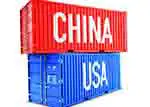
To give some context to the magnitude of China’s product surplus from exchanging exported and imported goods with the US, the $295.3 billion Chinese surplus with America in 2019 equals just over two-thirds (68.7%) of China’s overall $429.6 billion world trade surplus during 2019 when all countries are included. Globally, the increase in China’s trade surplus with all countries represents a 19.6% expansion in black ink for the People’s Republic from 2018 to 2019.
Key USA Product Trade Balances with China
China Surpluses
The following 25 products generated the greatest surpluses for China from its trade with the United States in 2019, generating a subtotal $209.7 billion in black ink for the People’s Republic.
- Phone system devices including smartphones: US$47.7 billion (down -9.1% from 2018)
- Computers, optical readers: $43.3 billion (down -8.5%)
- TV receivers/monitors/projectors: $8.8 billion (down -17.1%)
- Miscellaneous furniture: $8.4 billion (down -24.3%)
- Automobile parts/accessories: $8.1 billion (down -15.5%)
- Models, puzzles, miscellaneous toys: $8.1 billion (up 11%)
- Seats (excluding barber/dentist chairs): $8 billion (down -15.4%)
- Lamps, lighting, illuminated signs: $7.5 billion (down -12.7%)
- Electric water heaters, hair dryers: $6.1 billion (up 0.4%)
- Computer parts, accessories: $5.3 billion (down -55.7%)
- Miscellaneous plastic items: $5.2 billion (up 1%)
- Jerseys, pullovers (knit or crochet): $4.9 billion (down -0.9%)
- Women’s clothing (not knit or crochet): $4.7 billion (down -12.9%)
- Cases, handbags, wallets: $4.5 billion (down -26.1%)
- Microphones/headphones/amps: $3.8 billion (down -5%)
- Footwear (textile): $3.8 billion (down -7.3%)
- Pneumatic hand tools: $3.8 billion (up 4.8%)
- Sports equipment: $3.7 billion (up 7.4%)
- Table games, bowling equipment: $3.7 billion (down -30.4%)
- Footwear (leather): $3.5 billion (down -8.5%)
- Footwear (rubber or plastic): $3.4 billion (down -2.4%)
- Plastic tableware, kitchenware, toiletry: $3.4 billion (up 2.2%)
- Electrical machinery: $3.3 billion (down -4.1%)
- Electrical converters/power units: $3.3 billion (down -15.7%)
- Mattresses, quilts: $3.1 billion (down -13.8%)
The fastest-growing Chinese trade surplus garnered from exchanging products with America from 2018 to 2019 was for the models, puzzles and miscellaneous toys category thanks to its 11% gain. In second place for China’s growing black ink was sports equipment via a 7.4% increase, trailed by pneumatic hand tools (up 4.8%) then plastic tableware, kitchenware and toiletry (up 2.2%).
Leading reductions in China’s trade surpluses with the US belong to computer parts and accessories (down -55.7%), table games and bowling equipment (down -30.4%), cases, handbags and wallets (down -26.1%) then miscellaneous furniture (down -24.3%).
China Deficits
The following 25 products generated the greatest amounts of red ink for China trading with the United States in 2019, accounting for a -$80 billion negative subtotal for the People’s Republic exchanging goods with its North American competitor.
- Integrated circuits/microassemblies: -US$12.6 billion (up 18.9% from 2018)
- Cars: -$7.7 billion (down -5.2%)
- Soya beans: -$6.7 billion (down -5.2%)
- Miscellaneous aircraft, spacecraft (e.g. helicopters, launchers): -$5.9 billion (down -61.3%)
- Machinery for making semi-conductors: -$3.9 billion (up 4.8%)
- Turbo-jets: -$3.7 billion (up 32.4%)
- Crude oil: -$3.3 billion (down -51.3%)
- Blood fractions (including antisera): -$2.6 billion (up 4.1%)
- Physical/chemical analysis tools: -$1.6 billion (down -13.2%)
- Medication mixes in dosage: -$1.4 billion (up 1.3%)
- Electro-medical equipment (e.g. xrays): -$1.23 billion (up 6.1%)
- Other measuring/testing machines: -$1.15 billion (down -5.2%)
- Chemical woodpulp (non-dissolving): -$1.09 billion (down -21.9%)
- Polyacetal/ether/carbonates: -$985.9 million (down -1.7%)
- Paper/paperboard waste, scrap: -$921.4 million (down -42.7%)
- Orthopedic appliances: -$919.3 million (up 14.6%)
- Sawn wood: -$798.5 million (down -50.8%)
- Other diagnostic/lab reagents: -$789.9 million (up 5.1%)
- Ethylene polymers: -$787.9 million (down -29.9%)
- Rough wood: -$738 million (down -47%)
- Cotton (uncarded, uncombed): -$731.5 million (down -31.2%)
- Miscellaneous nuts: -$700.1 million (up 57.7%)
- Beauty/makeup/skin care preparations: -$547.2 million (up 415.9%)
- Chemical industry products/residuals: -$537.4 million (up 16.6%)
- Whole fish (frozen): -$508.6 million (down -6.4%)
Generating the greatest percentage increases for Chinese product deficits caused by trade with the US from 2018 to 2019 were beauty, makeup and skin care preparations (up 415.9%), miscellaneous nuts (up 57.7%), turbo-jets (up 32.4%), integrated circuits and microassemblies (up 18.9%) then chemical industry products and residuals (up 16.6%).
Leading the shrinkage in China’s product-specific deficits in the trade with America year over year were miscellaneous aircraft and spacecraft (down -61.3%), crude oil (down -51.3%), sawn wood (down -50.8%), rough wood (down -47%) then paper and paperboard waste or scrap (down -42.7%).
Sources
Research Sources:
International Trade Centre, Trade Map. Accessed on April 8, 2020
Investopedia, Net Exports Definition. Accessed on April 8, 2020
See also Top United States Trade Balances, Top Chinese Trade Balances